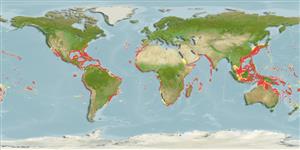Actinopterygii (ray-finned fishes) >
Perciformes (Perch-likes) >
Bramidae (Pomfrets)
Etymology: Taractes: Greek, taraktes = confusion; for the pletora of names that have been applied to this fish (Ref. 45335).
Environment / Climate / Range
Ecology
Marine; benthopelagic; oceanodromous (Ref. 51243); depth range 0 - 600 m (Ref. 82736). Tropical, preferred ?
Pacific and Atlantic: widely distributed in tropical waters (Ref. 559). Eastern Central Pacific: Costa Rica to Peru. Eastern Atlantic: off west Africa. Western Atlantic: Gulf of Mexico, Trinidad. Not known from the Indian Ocean (Ref. 4936). Recently reported in Aden Gulf, Arabian Sea (Ref. 85285). Highly migratory species, Annex I of the 1982 Convention on the Law of the Sea (Ref. 26139).
Size / Weight / Age
Maturity: Lm ? range ? - ? cm
Max length : 89.0 cm TL male/unsexed; (Ref. 97146); common length : 30.0 cm TL male/unsexed; (Ref. 55763)
Dorsal
spines
(total): 0;
Dorsal
soft rays
(total): 30-32;
Anal
spines: 0;
Anal
soft rays: 21 - 23. Caudal peduncle with a strong keel formed of enlarged and fused scales. Scaleless areas above and behind the eyes. Lateral line in adults obsolete. Fins of juveniles very long. Attains 70 cm SL.
Adults occur from shallow water to about 600 m depth offshore (Ref. 82736). Often solitary (Ref. 82736).
Life cycle and mating behavior
Maturity | Reproduction | Spawning | Eggs | Fecundity | Larvae
Gomes, J., 1990. Bramidae. p. 758-764. In J.C. Quero, J.C. Hureau, C. Karrer, A. Post and L. Saldanha (eds.) Check-list of the fishes of the eastern tropical Atlantic (CLOFETA). JNCT, Lisbon; SEI, Paris; and UNESCO, Paris. Vol. 2. (Ref. 4936)
IUCN Red List Status (Ref. 115185)
CITES (Ref. 94142)
Not Evaluated
Threat to humans
Harmless
Human uses
Fisheries: commercial
More information
Common namesSynonymsMetabolismPredatorsEcotoxicologyReproductionMaturitySpawningFecundityEggsEgg development
ReferencesAquacultureAquaculture profileStrainsGeneticsAllele frequenciesHeritabilityDiseasesProcessingMass conversion
Tools
Special reports
Download XML
Internet sources
